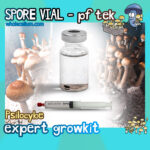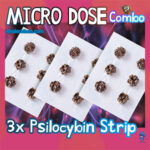After a while this window of intense learning capability gets steadily smaller, and it makes it harder for you to learn new things — be it languages, how to use the latest technology, the ability to embrace societal change, or to free yourself from old ingrained habits. However, a recent study has suggested that there may be a way to reopen this fertile window of learning. All with a little help of — you guessed it — psychedelics.
According to new research from Johns Hopkins University, several different psychedelics may have the capability to temporarily unlock ‘critical periods’ which make it easier for our brains to learn and develop like a child’s does. A ‘critical period’ is a short developmental window in which an animal has the chance to learn a behavior. For example, certain types of geese will associate whatever is in their field of vision for the first 48 hours of their lives as their mother. It doesn’t matter if the first thing they see is their mother goose, a human, or a jar of pickles. Once that critical window is passed, this association will stick with them for life.

Psychedelics Can Reopen the ‘Critical Period’
The research, which was published in June by the journal Nature, showed that administering psilocybin, LSD, MDMA, ibogaine or ketamine into adult mice caused their youthful critical period for learning based on socially rewarding experiences to reopen. This occurred after the immediate effects of the drug subsided.
Appreciating, of course, the potential for difference between the effects on rodents vs. the effects on humans, the researchers observed that how long the critical period remained open in the rodent subjects was proportional to the length of each drug’s effects in people. For example, ketamine has a short duration, therefore it opened the critical period for a few days. Whereas ibogaine, with a longer duration, opened the critical period for four weeks. (MDMA and psilocybin left the critical period open for two weeks, and LSD three.)

The researchers had done previous study using just MDMA. In it they had found that the drug could trigger the opening of critical periods. This new research found that this effect was also prompted by psilocybin, LSD, ibogaine and ketamine.
Teaching ‘Old Mice New Tricks’
Neuroscientist Gül Dölen, whose lab a The Center for Psychedelic and Consciousness Research at Johns Hopkins University carried out this new study, as well as the preceding MDMA research, stated;
“There’s an adage you can’t teach an old dog new tricks… And when we gave psychedelics, what we found is that we can teach old mice new tricks.”
Excitingly, she also said she believes that psychedelics “are the master key for unlocking lots of different critical periods.”
Famously, psychedelics are linked to the ability to change one’s perceptions of existence and spirituality. They can foster a new sense of discovery about the self and/or the world. In the study, the researchers sought to explore this by conducting behavioral tests in adult mice. These were to measure how easily they learned from their social environment. The experiment involved training mice to grow an association between an environment connected to social interaction, vs. another space connected to being alone. After administering the psychedelic the researchers compared the time spent by the mice in each environment. From this they could observe if the critical period had opened again in the adult mice. This would enable them to learn the benefits of a social environment again — something that is normally learned only by young, juvenile mice.
What is Plasticity?
Plasticity, in relation to the nervous system, is the ability for it to change and adapt. However, researchers usually agree that an increase in plasticity falls short in describing the effects of psychedelics. For example, substances like cocaine or fentanyl also promote plasticity in the brain, the reward centers specifically. This is part of their powerful addictiveness, a quality that psychedelics do not have.
To differentiate, the authors of the study used the term “metaplasticity”, meaning the plasticity of plasticity. This was used to describe the ability of psychedelics to reopen critical periods. This research is among the first trials that suggest, based on multiple threads of evidence, that metaplasticity may be the crux of how psychedelics work.

In fact, earlier in June, Nature Neuroscience published a study that suggests LSD could cause critical period-like plasticity, but in the visual cortex. This is another example of a study that cites metaplasticity as the root cause of psychedelics’ effectiveness. Researchers posit that this could allow mice with “ocular dominance” or a ‘lazy-eye’, to recalibrate or restabilize their eyes.
Ibogaine and Ketamine: Psychedelics?
However, Dr Robin Carhart-Harris, Professor of Neurology, Psychiatry and Behavioral Sciences at University of California San Francisco, as well as figure at the forefront of psychedelic research, had a few questions about the chosen phrasing. In an email he praised the researchers’ methods as “sophisticated and impressive“. However, he queried that ‘metaplasticity’ was the right term to describe the critical period reopening seen in the study. Additionally he questioned whether the inclusion of ketamine and ibogaine in the bracket of ‘psychedelics’ was appropriate.
The ‘Pac-Man’ Enzyme

The paper’s research team also found that the brains of the mice who had been administered psychedelics had higher amounts of matrix metalloproteinases, or what are known as “Pac-Man”-like enzymes. These clear the space between neural synapses. The researchers posit that in adulthood, the spaces around neurons become clogged with molecules that hinder plasticity. When these are cleared, the researchers believe, it creates a fresh biological state for neurons to reconfigure themselves with greater ease.
Dölen explained;
“What we think is happening is that when you give the psychedelic, it chews up the extracellular matrix, and that dissolution of the extracellular matrix makes the synapses malleable again,”
On analyzing the brains of the mice given psychedelics, the researchers noted the expression of 65 different genes. Of these genes 20% were associated with the regulation of the extracellular matrix. This led them to believe that the extracellular matrix has a key role in how psychedelics reopen critical periods. This points to the possibility of achieving a deeper understanding of the therapeutic benefits of psychedelics.
Defining Psychedelics
Until this point, psychedelic researchers have hypothesized that the 5HT2a serotonin receptor is likely fundamental to the action of psychedelics. A new challenge to this theory is the inclusion of ketamine and ibogaine. This is because they do not exert their main effects through this receptor. This raises questions about what actually defines a psychedelic, as Dr Carhart-Harris flagged up. Researchers recently published a proposed consensus statement to confirm that only substances that act on 5HT2a receptors and cause psilocybin or LSD-esque effects could be categorized as psychedelics.
But, Dölen’s team disagrees. They argue that what should define a psychedelic is not its action on the 5HT2a receptors, but rather its ability to re-open the critical period window.
“Our first piece of evidence to support that was that all of the psychedelics do it. Whether they’re dissociative psychedelics, hallucinogenic psychedelics, oneirogenic psychedelics, or empathogenic psychedelics – they all do it.”
Dölen suggests that “what it feels like to re-open all your critical periods is just what it feels like to be in an altered state of consciousness.”
A Whole New Set of Possibilities

And regardless of categorization, according to Dölen, the implications of being able to reopen critical periods could be huge. It could mean that the therapeutic potential of psychedelics reaches far beyond psychotherapeutic, or mental health conditions, such as depression or addiction. It could extend to include conditions previously thought incurable such as stroke, deafness or lazy eyes.
“This paradigm shift, really, in how we imagine psychedelics are having these therapeutic effects, not only offers a better explanation for the ones we’re already trying to cure, but opens up the door for a bunch of other diseases that we didn’t even think of,” she says.
Learning to Integrate the Critical Period
It also means that a great deal more research needs to be done into the ideal post-psychedelic therapy period. For example, after psilocybin therapy, you know that your critical period is open for two weeks. This means that you can focus on intensive integration during this time. This way lasting changes can be made. As Dölen says;
“Too often, after having a procedure or treatment, people go back to their chaotic, busy lives that can be overwhelming. Clinicians may want to consider the time period after a psychedelic drug dose as a time to heal and learn, much like we do for open heart surgery,”
As well as these vital therapeutic strides forward — who knows? Maybe we’ll see a future in which people use these post-psychedelic critical periods for many different things. To cram for exams, learn new languages, or even bridge gaps between generations? Either way, as we continue down the rabbit hole of psychedelic research, more, and more, amazing things are uncovered at every turn.
Maybe an old dog* can learn new tricks after all… with a little help from magic mushrooms.

*The dog is a metaphor! Please don’t give any dog shrooms. Give yourself shrooms… 😜





